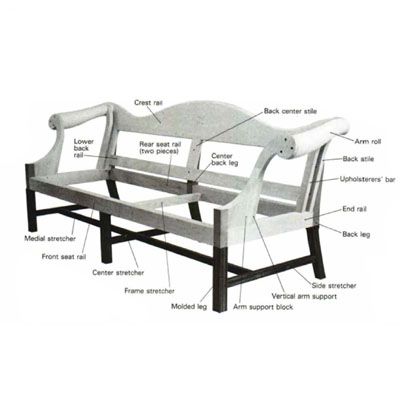Chippendale Sofa
Templates for the basic frame, and some design options
Synopsis: How to reproduce Chippendale sofas using period construction techniques. Norman L. Vandal studied Chippendale camelback sofas in museums and books and found a great resource in The Magazine Antiques, which showed sofas stripped of upholstery. Here he shares his templates and some variations; using these, you’ll avoid problems, he says, and everything will go together and stand square. He offers advice on what woods to use for primary and secondary parts, and his construction instructions are in two places: the text of the article and on the template drawings. He also talks about the old style vs. newer styles of attaching upholstery, and tells you which he prefers. Side information covers getting a frame upholstered and variations on leg styles.
Any professional woodworker has to keep an eye on the market. Over the years I’ve earned a living making things that simply weren’t available anywhere else, everything from period architectural components to period planes for restorers who wanted to stick their own moldings.
Many of my furniture customers come to me because of the double jeopardy of buying antiques: originals are not only very high in price, they may also be in very poor condition. In January 1983, for instance, a Philadelphia camelback sofa sold at Christie’s, New York, for the record price of $264,000, even though it had some serious problems—amputated leg bottoms had been pieced in, the rear legs had been cut off and refastened, and the stretchers had been replaced. Keeping all this in mind, I thought it a good idea to add a camelback sofa to my designs.
I wanted to stay faithful to the lines and solid joinery of the originals, so I studied Chippendale sofas in museums and period-furniture books. Surprisingly, my best source turned out to be copies of The Magazine Antiques. Dealers like to sell furniture stripped of its upholstery to ensure buyers that it’s original, and many of the ads showed the entire frame and the joinery. I saw that period cabinetmakers varied the shape of the legs, front seat rail and crest rail without changing the shape of the basic frame much. I figured that I could do the same for my customers, and build a good frame to sell for a little over a thousand dollars, which compares favorably in price with factory “reproductions,” and, in my opinion, greatly surpasses them in quality.
Templates and variations— Joinery details are shown on the facing page. Sofas are not as difficult to make as they may Adapting the basic templates yields this Philadelphia-style sofa with serpentine front. look. Unlike upholstered chair seats, which are always trapezoidal, sofa seats are rectangular. Thus a measured drawing of the frame’s end view shows many parts in true dimension. With these parts as a starting point, I worked out a reliable set of templates, shown throughout this article, for the angled parts. The templates take care of the tricky problems, ensuring that everything will go together and stand square.
When building a sofa, you first make the end frames, which include the legs, end rails and side stretchers.
From Fine Woodworking #49
For the full article, download the PDF below:
Fine Woodworking Recommended Products

Bessey EKH Trigger Clamps

Stanley Powerlock 16-ft. tape measure

Dubuque Clamp Works Bar Clamps - 4 pack




















Log in or create an account to post a comment.
Sign up Log in